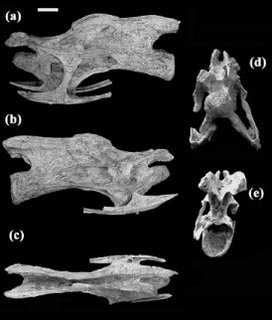
Abstract: The first specimen of the new sauropod Erketu ellisoni, from the Lower Cretaceous of the eastern Gobi of Dornogov, Mongolia, is described here. The specimen comprises a well-preserved articulated anterior cervical series, an articulated lower hindlimb, and a sternal plate. This sauropod displays a unique combination of features including low, bifid neural spines, elongate cervical centra, and crescent-shaped sternal plates.
Computed tomography imaging reveals the vertebrae were extensively invaded with pneumatic camellae. The holotype individual of Erketu was of modest mass relative to other neosauropods, but had an extremely elongate neck. Phylogenetic analysis indicates Erketu is a member of the Somphospondyli and may belong to a more exclusive clade therein--P. [1].
Systematics:
Sauropoda Marsh, 1878
Neosauropoda Bonaparte, 1986
Macronaria Wilson and Sereno, 1998
Titanosauriformes Salgado, Coria and Calvo, 1997
Somphospondyli Wilson and Sereno, 1998
Erketu ellisoni gen sp. nov.
Holotype: IGM 100/1803: articulated cervical series including complete first through fifth cervical vertebrate, partial sixth cervical vertebra, right sternal plate, articulated right tibia, fibula, astragalus and calcaneum.
Etymology: Erketu: In Mongolian shamanistic tradition, there are 99 Tengri (deities). Erketü Tengri is the Mighty Tengri, a creator-god who called Yesügei, the father of Chingis Khan, into being. ellisoni: In honor of Mick Ellison, for his contributions to ongoing AMNH dinosaur research.
Type locality and Horizon: Bor Guvé: late Early Cretaceous. Stratigraphically, the beds at this locality lie below the Tsaagan Tsonch beds (a unit that contains Iguanodon orientalis) and above the Khara Khuutul beds, both believed to be of late Early Cretaceous age (Shuvalov, 2000). The lack of materials suitable for radiometric dating leaves the exact age of this locality uncertain.

No comments:
Post a Comment